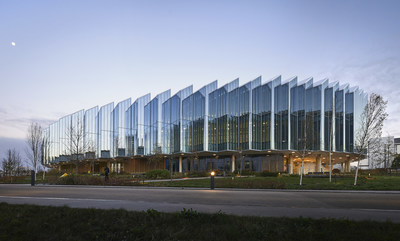HONEYWELL TEAMS WITH ASTRAZENECA TO DEVELOP NEXT-GENERATION RESPIRATORY INHALERS THAT USE NEAR-ZERO GLOBAL WARMING POTENTIAL PROPELLANT
Honeywell and AstraZeneca announced a partnership to develop next-generation respiratory inhalers utilizing near-zero global warming potential (GWP) propellants. This collaboration addresses the needs of 384 million COPD and 339 million asthma sufferers, aiming to reduce greenhouse gas emissions by up to 99.9% compared to traditional inhalers. Honeywell's Solstice Air, a non-flammable propellant, has shown promising results in clinical trials. AstraZeneca plans to transition its Breztri Aerosphere medicine to this innovative platform pending regulatory approval. Both companies aim for sustainable healthcare solutions.
- Partnership aims to reduce inhaler emissions by up to 99.9%.
- Phase I clinical trial for HFO-1234ze propellant showed positive results.
- AstraZeneca plans to transition Breztri Aerosphere to the new platform.
- None.
Insights
Analyzing...
CHARLOTTE, N.C., Feb. 22, 2022 /PRNewswire/ -- Honeywell (Nasdaq: HON) today announced a commercial partnership with AstraZeneca (LON: AZN) to develop and bring to market next-generation respiratory inhalers that use near-zero global warming potential (GWP) propellants to treat asthma and chronic obstructive pulmonary disease (COPD).
As many as 384 million people suffer from COPD, a progressive respiratory disease, and 339 million children and adults suffer from asthma.1,2 Many of these patients are currently treated using pressurized metered dose inhalers (pMDIs) that can contribute to the global carbon footprint of respiratory care.
AstraZeneca, a global leader in treatment of respiratory diseases, is working to incorporate Honeywell's Solstice® Air (HFO-1234ze cGMP) technology as a medical propellant, reducing the greenhouse gas emissions of the pMDIs by up to 99.9 percent when compared to current inhaler propellants. Solstice Air is the only non-flammable, near zero GWP propellant available and in clinical development today for pMDIs.
A recently completed Phase I clinical trial of the propellant HFO-1234ze in a pMDI containing budesonide, glycopyrronium, formoterol fumarate in healthy adults was positive, demonstrating similar safety and tolerability profile and systemic exposure of the active ingredients when compared to Breztri Aerosphere (budesonide/ glycopyrronium/ formoterol fumarate). AstraZeneca expects Breztri Aerosphere to be the first medicine to transition to the next generation pMDI platform, subject to regulatory approval.
Following these positive results from the Phase I trial, AstraZeneca will advance a commercial partnership with Honeywell to develop their triple-combination therapy, Breztri Aerosphere, using Honeywell's near-zero GWP propellant technology.
Pascal Soriot, chief executive officer, AstraZeneca said: "We are making great progress on our ambition to be zero carbon across our global operations by the end of 2025 and carbon negative across our entire value chain by 2030. Our collaboration with Honeywell demonstrates AstraZeneca's commitment to advancing sustainable healthcare innovation, with the aim of improving outcomes for patients while reducing our environmental footprint.
"The work we are doing with AstraZeneca developing a respiratory inhaler, with a new near-zero Global Warming Potential propellant, is tremendously important for both the environment and patients with respiratory issues," said Darius Adamczyk, chairman and chief executive officer of Honeywell. "Our goal is to reduce respiratory healthcare carbon emissions without restricting patient choice or risking improvement in health outcomes. This is just one example of how Honeywell is innovating to help our customers, like AstraZeneca, reach their environmental goals and keep their focus on quality for their customers."
Solstice Air is a breakthrough for pressurized metered dose inhalers (pMDIs). A nonflammable and low global warming potential (GWP) alternative to hydrofluorocarbons, it is non-ozone-depleting, VOC-exempt (U.S. EPA and CARB), with an ultra-low GWP close to 1. It's the only next-generation HFO-based propellant not currently subject to quota-based allocation under the recent American Innovation and Manufacturing (AIM) of 2020.
Honeywell has invested a billion dollars in research, development, and new capacity for its Solstice technology, having anticipated the need for lower-GWP solutions to combat climate change more than a decade ago. The product line, which helps customers lower their greenhouse gas emissions and improve energy efficiency without sacrificing end-product performance, includes refrigerants for supermarkets, air conditioning for cars and trucks, blowing agents for insulation, propellants for personal and household care and solvents for cleaning solutions.
Customers utilizing Solstice technology have avoided potential release of the equivalent of more than 250 million metric tons of carbon dioxide into the atmosphere, equal to eliminating the potential emissions from more than 52 million cars for one year.
Honeywell committed to achieving carbon neutrality in its operations and facilities by 2035. This commitment builds on the company's track record of sharply reducing the greenhouse gas intensity of its operations and facilities as well as its decades-long history of innovation to help its customers meet their environmental and social goals. About half of Honeywell's new product introduction research and development investment is directed toward products that improve environmental and social outcomes for customers.
Honeywell (www.honeywell.com) is a Fortune 100 technology company that delivers industry-specific solutions that include aerospace products and services; control technologies for buildings and industry; and performance materials globally. Our technologies help aircraft, buildings, manufacturing plants, supply chains, and workers become more connected to make our world smarter, safer, and more sustainable. For more news and information on Honeywell, please visit www.honeywell.com/newsroom.
This release contains certain statements that may be deemed "forward-looking statements" within the meaning of Section 21E of the Securities Exchange Act of 1934. All statements, other than statements of historical fact, that address activities, events or developments that we or our management intends, expects, projects, believes or anticipates will or may occur in the future are forward-looking statements. Such statements are based upon certain assumptions and assessments made by our management in light of their experience and their perception of historical trends, current economic and industry conditions, expected future developments and other factors they believe to be appropriate. The forward-looking statements included in this release are also subject to a number of material risks and uncertainties, including but not limited to economic, competitive, governmental, and technological factors affecting our operations, markets, products, services and prices. Such forward-looking statements are not guarantees of future performance, and actual results, developments and business decisions may differ from those envisaged by such forward-looking statements. We identify the principal risks and uncertainties that affect our performance in our Form 10-K and other filings with the Securities and Exchange Commission.
1. The Global Asthma Network. The Global Asthma Report 2018. [Online]. Available at: http://www.globalasthmanetwork.org/.
2. World Health Organization. The top 10 causes of death. [Online. Available at: https://www.who.int/news-room/fact-sheets/detail/the-top-10-causes-of-death
3. Adeloye D, et al. Global Health Epidemiology Reference Group (GHERG). Global and regional estimates of COPD prevalence: Systematic review and meta-analysis. J Glob Health. 2015; 5 (2): 020415.
Media contact: | Investor contact: |
Mike Hockey | Sean Meakim |
(832) 285 4933 | (704) 627 6200 |
![]() View original content to download multimedia:https://www.prnewswire.com/news-releases/honeywell-teams-with-astrazeneca-to-develop-next-generation-respiratory-inhalers-that-use-near-zero-global-warming-potential-propellant-301486896.html
View original content to download multimedia:https://www.prnewswire.com/news-releases/honeywell-teams-with-astrazeneca-to-develop-next-generation-respiratory-inhalers-that-use-near-zero-global-warming-potential-propellant-301486896.html
SOURCE Honeywell







